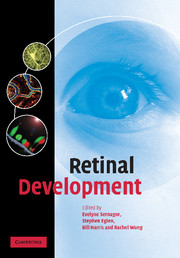Book contents
- Frontmatter
- Contents
- List of contributors
- Foreword
- Preface
- Acknowledgements
- 1 Introduction – from eye field to eyesight
- 2 Formation of the eye field
- 3 Retinal neurogenesis
- 4 Cell migration
- 5 Cell determination
- 6 Neurotransmitters and neurotrophins
- 7 Comparison of development of the primate fovea centralis with peripheral retina
- 8 Optic nerve formation
- 9 Glial cells in the developing retina
- 10 Retinal mosaics
- 11 Programmed cell death
- 12 Dendritic growth
- 13 Synaptogenesis and early neural activity
- 14 Emergence of light responses
- New perspectives
- Index
- Plate section
- References
4 - Cell migration
Published online by Cambridge University Press: 22 August 2009
- Frontmatter
- Contents
- List of contributors
- Foreword
- Preface
- Acknowledgements
- 1 Introduction – from eye field to eyesight
- 2 Formation of the eye field
- 3 Retinal neurogenesis
- 4 Cell migration
- 5 Cell determination
- 6 Neurotransmitters and neurotrophins
- 7 Comparison of development of the primate fovea centralis with peripheral retina
- 8 Optic nerve formation
- 9 Glial cells in the developing retina
- 10 Retinal mosaics
- 11 Programmed cell death
- 12 Dendritic growth
- 13 Synaptogenesis and early neural activity
- 14 Emergence of light responses
- New perspectives
- Index
- Plate section
- References
Summary
Introduction
Like most parts of the CNS, retinal cells are generated some distance from where they will ultimately reside. Migration to the correct place at the right time is vital for their ability to make appropriate synaptic connections and function normally. Understanding how each of the seven retinal cell types migrate to their appropriate layer is critical to understanding how this CNS structure becomes organized during development.
The entire retinal neuroepithelium is a proliferative zone early in development. Retinal neuroepithelial cells with cytoplasmic processes that extend from the outer limiting membrane (OLM) to the inner limiting membrane (ILM) engage in interkinetic nuclear migration, a process by which their nuclei migrate within the cytoplasm, undergoing different phases of the cell cycle at different depths within the neuroepithelium (see Chapter 3). Thus, neuroepithelial cells in S-phase have their nuclei positioned near the ILM, and they enter M-phase at the OLM. Consequently, following a final mitotic divison, when cells leave the cell cycle they do so adjacent to the OLM. Newborn postmitotic cells therefore need to migrate varying distances to take up residence in one of the three prospective cellular layers. Cells destined for the ganglion cell layer (GCL), for example, have comparatively longer distances to travel than rod and cone photoreceptors. Birthdating studies in diverse species have shown that the first cohort of cells to become postmitotic are ganglion cells (Prada et al., 1991; Rapaport et al., 1996, 2004; Hu and Easter, 1999) (see Chapter 3).
- Type
- Chapter
- Information
- Retinal Development , pp. 59 - 74Publisher: Cambridge University PressPrint publication year: 2006



